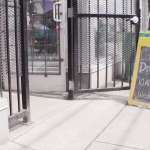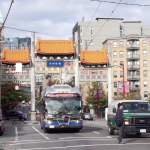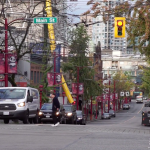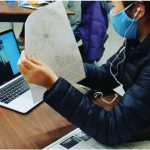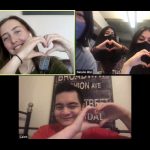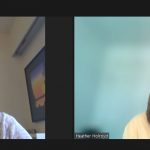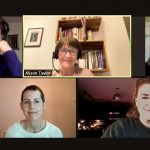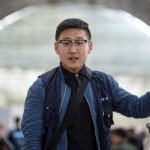Part 1 of 4.
By Robyn Taylor-Neu
“Are you waiting? Am I in your way?” The woman swivels towards me in concern. Her bespectacled companion furrows his brow at her laptop screen and then looks back to his own.
“Uhhhh, no, I’m…” I stammer, gesturing vaguely with my notebook. “Just hanging out, I guess.”
“Oh, ok,” she nods, but shuffles her chair sideways all the same and shuffles papers from the table in front of me before turning back to the laptops. From what I can tell, the man is helping her sort out an online log-in situation. I sympathize. Glancing around the room, I note three or four similar pairs, angling towards their respective screens. I realise, after a moment, that I’m not sure who’s a community member seeking tech help, who’s a UBC volunteer, and who’s a “peer educator.”
Diagonally across the square perimeter of tables, William chats with a young man, a student volunteer from the univresity, I recall. Dionne stands at the other end of the table, joking with a community member. Although the two organizers appear absorbed in conversation, I suspect otherwise. Their eyes flicker around the tables, taking stock, even as they laugh or smile or shrug in response.
“It’s about being attentive,” Dionne Pelan says later, describing her role at the Tech Café, as Computer/ Drop-In Coordinator at the UBC Learning Exchange. William Booth, the Coordinator of Vancouver’s DTES Literacy Roundtable, nods in agreement. We’re seated around a table, Dionne, William, Alex, and I. William and Dionne have graciously taken time to chat about the initiative that they jointly coordinate, the Tech Café. In simplest terms, the Café is a literacy program based out of several locations in the DTES and co-supported by the UBC Learning Exchange and the Downtown Eastside (DTES) Literacy Roundtable. Its express aim, in one commentator’s view, is to help Downtown Eastsiders “get tech savvy.” As our conversation with William and Dionne unfolds, however, it becomes clear that there’s much more to the story. And “being attentive” is at the crux of it.
“So, you two met, you had the idea for the initiative, and…?” I prompt, perhaps exposing my status as interview ingenue. William and Dionne exchange a look and a laugh.
“That’s not exactly how it happened,” William explains. The Tech Café, Alex and I learn, grew organically from an earlier initiative, the LinkVan app, which in turn emerged from William’s and Dionne’s long-term involvement in the Downtown East Side Community. Knowledge, passion, experience, and care for the community have all been essential in the project’s development—but at its root, I’d contend, is a well-honed habit of being attentive.
“We agreed that the biggest problem [in the DTES community] was that people did not know how or where to access services. So we were having this conversation and a UBC student volunteer overheard. He said, I’ve made an app and would love to make another for this.’” Eager to put his computer science skills to work in the “real world,” he built a mobile app that collected information about community resources in a digital directory.

The prospect of such an app was exciting. But university-community interactions are shadowed by a persistent, pessimistic (though not entirely inaccurate) narrative. It goes something like this: once upon a time, there was a marginalized yet vibrant urban community that, one day, falls prey to rapacious university researchers; these sinister and self-interested investigators descend upon the unsuspecting (or perhaps resistant) victim, drain it dry, and suck the marrow from its bones… Ok, I’ll admit that’s rather melodramatic.
Dionne explains, more matter-of-factly: “Universities themselves tend to have a fairly poor reputation within the community or communities because often it’s not a reciprocal relationship… the researchers come down, the students come down, they get the experience… they get their needs met.” This situation is, emphatically, not what the UBC Learning Exchange is all about. And in the case of the LinkVan app, Dionne and William wanted to make sure that the project served the community as intended.
To avoid the pitfalls of a prescriptive, paternalistic approach, they solicited input from the community. In these early days, Willam recounts, they recruited community members to take the app out into the streets, the parks, the shelters, and the community centers of the DTES. These “community ambassadors” consulted their peers regarding what might work, what was needed, what was wanted… and what wasn’t. When I asked whether this method of “consultation” was central to their practice, however, William was quick to clarify: “I think the word conversation is probably a more accurate term than consultation.”
There’s a lot in that difference—it’s a difference that makes a difference, one might say. “Consultation” not only suggests a business model—its linguistic register is private-professional—but it also implies a hierarchy between consulter and consulted. “Conversation,” on the other hand, describes a different form of sociality: the implied interaction involves evenly-positioned conversationalists.
From these conversations, the team gleaned valuable insight into what the app should include. But when they observed how it operated in practice, a new challenge became apparent. “One of the things that we noticed during that phase was that there were a lot of folks…who didn’t actually know how to use computers or maybe they didn’t know how to use their device to access things,” Dionne recalls. “It wasn’t enough just to build the app. Like we kind of had a responsibility, if we wanted people to use it, to show them how to use the app, but in the process also [show] them how to use their technology or devices.”
This need for “tech tutelage,” William and Dionne discovered, was unmet by traditional digital literacy programs because many DTES residents were wary of formal education (many of them, for good reason). Rather than see the situation as an obstacle to the app’s success, though, William and Dionne saw an opportunity: an opportunity to take what had worked with the app—i.e., a community conversation model and commitment to “meeting people where they’re at” (figuratively and literally)—and apply it to address this newly exposed need.
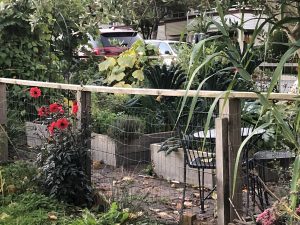
********

